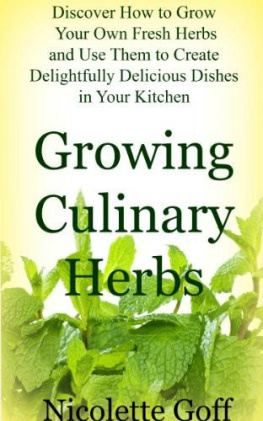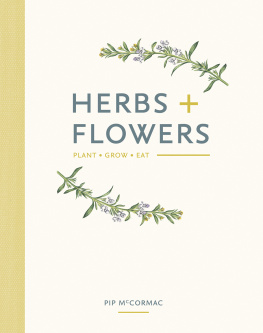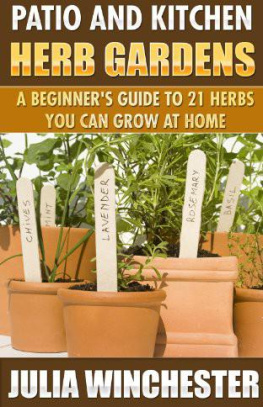Growing Culinary Herbs
Discover How to Grow Your Own Fresh Herbs and
Use them to Create Delightful and Delicious Dishes
By Nicolette Goff
Through Nanas Garden Gate
Copyright 2013, all rights reserved
Reviews of How to Preserve and Enjoy Your Garden Herbs (Kindle Edition)
Great Tips Linda L. Strother (Asheville, NC)
Every year I grow herbs because I love fresh herbs in my food but I really did not know how to dry and preserve herbs. I found this book packed with great useful information. I had no idea that I could freeze herbs in ice cube trays, brilliant idea. Next growing season I will be armed with a game plan.
Very Precise and To the Point AngelicMom "Angel" (Portage, IN USA)
This is a quick read but it is to the point-there are some nice tips. She explains what herbs work well with what oils, vinegars, etc. Excellent book for the topic of preserving your fresh herbs. I look forward to reading more from her.
Great Advice, Quick and Simple Hannah E.
I'm trying a new, organic-type diet and I wanted to grow a lot of my own herbs and spices, but I didn't really know where to start. I stumbled upon this book and it was a great help, quick and to the point. I learned what I needed to know in no time, and I'm already planning my garden for this year. I'm excited because a lot of the recipes called for a lot of the herbs I was growing, so now I can use them from home and not have to go the store.
My sincere thanks to all who read my first herb book, How to Preserve and Enjoy Your Garden Herbs , and took the time to write a review. Im pleased that I could add value, and I appreciate you!
Can I ask a quick favor?
After you finish reading this e-book, Id be grateful if you wrote a REVIEW on Amazon.
Your feedback is much appreciated and will help me improve the next edition.
Nicolette
T ABLE OF C ONTENTS
I NTRODUCTION:
Botanically, we define an herb as a plant whose stem does not produce woody, persistent tissue and generally dies back at the end of each growing season .
However, many of us think of herbs as edible plants used to flavor foods, and some of the herbs we grow in our kitchen gardens definitely do not fit that botanical definition.
It is not a very helpful definition, since it includes many plants we wouldnt think of as herbs, and leaves out a lot that are favorites in the kitchen.
However, one dictionary definition is much closer to how we view herbs:
Any of various often aromatic plants used especially in medicine or as seasoning.
Although herbs have a long history as medicinals, I have not included that information in this book.
This book is intended to be a guide to herbs for both the gardener and the cook how to grow them and how to use them in the kitchen. It includes a detailed planting, growing and harvesting guide to 21 of the most common culinary herbs.
It is also a guide for the chef in your kitchen. You will find a wealth of ideas for using the herbs you grow. Learn which herbs marry well with which vegetables and how to prepare tasty herbal butters, sauces and dressings.
The short recipe section will, I hope, inspire you to experiment on your own with the herbs you grow. From herb teas to savory sauces, your garden herbs make cooking - and eating - a taste adventure.
Lets begin with a short history of these fascinating plants
A S HORT H ISTORY OF H ERBS
The history of herbs is almost as old as the history of man.
From earliest times, we humans have used plants for a wide range of purposes to fight disease, for their beauty, to enhance the flavor of foods, to make soothing or invigorating teas, and for their delicious aromas.
Paleontologists discovered that the ancient Egyptians used herbs even before the pharaohs ordered the building of the pyramids.
You need look no further than the Bible to see how herbs were not only grown and used, but actually were tokens of currency. Read through the gospels of Matthew and Luke. You'll find references to tithes paid in herbs like mint, cumin, and other herbs that were deemed valuable.
Ancient Chinese, Egyptians and Greeks all recorded how herbs were used, both medicinally and to flavor foods. Many of these early herbal remedies became the standard treatments herbalists and doctors used for hundreds of years. These useful plants, both culinary and medicinal, spread throughout Europe with the expanding Roman Empire.
But different cultures used herbs in many other ways. Sybarite Greeks slept on beds of fresh rose petals. Other herbs were strewn on floors, releasing their scents as people trod on them. They masked the odors from poor sanitation that pervaded homes and streets.
Scented smoke from herbs burnt on ceremonial altars drifted through the air. The aromatic herbal steam from public bathhouses wafted through the air, where mint and thyme scented the waters and were rubbed on the skin of bathers.
Flowers such as roses, chamomile, bergamot and violets were eaten, brewed as teas, added to wine, and enjoyed in every possible way. Herbs still familiar today flavored foods and wines, and acres of certain herbs were grown to attract bees and produce honey.
Herbs even appeared in Greek mythology, with special ones dedicated to different gods.
The Romans enjoyed herbs as well. Their baths were made fragrant with lavender and roses, and rich Romans stuffed their mattresses with these fragrant and sleep-inducing herbs.
Roman cooks flavored their foods with mint sauces, saffron, garlic and various other native Mediterranean herbs, many still in use today. Rose petals and clove carnations garnished dishes and added flavor to wine. As the Roman Empire expanded, these herbs traveled with the cooks and colonizers throughout the empire.
After Rome fell, and barbarous tribes effectively wiped out Roman culture in many parts of Europe, gardens and orchards fell into decay. Some of the plants vanished, while others managed to naturalize and survive.
As these tribes, especially the Anglo-Saxons, traveled and settled, they acquired a taste for the local foods. They became great herb-fanciers, with cultivation and use of over 500 plants, both for culinary and medicinal use.
In kitchens and monasteries, monks and cooks distilled liqueurs and digestive drinks flavored with herbs. Examples are wormwood in vermouth and absinthe, balm, hyssop and angelica in Chartreuse, and saffron, mint and fennel in strega. Distillers closely guard their secret recipes even today.
Returning Crusaders brought other herbs and plants to England and the Continent, along with a taste for more exotic flavors. These new plants flavored food, freshened clothing, deterred insects and even were held up to the nose to mask the unsanitary smells of the streets. Pilgrimage parties acquired a taste for foreign foods and medicinal knowledge; and the uses of herbs, both culinary and medicinal, spread.
Herb gardens graced many homes in Tudor England. The plants were important for doctoring and to improve the taste of foods. Cooks began to use a variety of herbs in different ways. Lovage, celery, parsley, dill, mint, and thyme were some of the earliest culinary additions to the cooks herb garden.
Cooks devised elaborate sauces with herbs, garnished food with them, and spiced up stuffings for meats and poultry. They used herbs in flavored puddings, sweetmeats and jellies. Many of the sauces devised over the last 5 centuries are still used by chefs today.
Throughout the ages, herbs continued to be grown in the physic gardens in monasteries.

Monks and nuns recorded their ancient medicinal and culinary uses in manuscripts. Homemakers and local wise women created simple recipes for cures and health-giving tonics.
Next page











